George I of Greece
George I (Greek: Γεώργιος Α΄, Geórgios I; 24 December 1845 – 18 March 1913) was King of Greece from 1863 until his assassination in 1913.
| George I | |
|---|---|
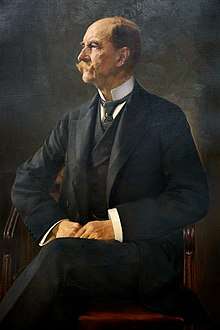 Posthumous portrait by Georgios Jakobides, 1914 | |
| King of the Hellenes | |
| Reign | 30 March 1863 – 18 March 1913[1] |
| Predecessor | Otto I |
| Successor | Constantine I |
| Prime Ministers | See list
|
| Born | Prince William of Schleswig-Holstein-Sonderburg-Glücksburg 24 December 1845 Copenhagen, Denmark |
| Died | 18 March 1913 (aged 67)[1] Thessaloniki[2] |
| Burial | Royal Cemetery, Tatoi Palace, Greece |
| Spouse | Grand Duchess Olga Constantinovna of Russia
( m. 1867) |
| Issue | |
| House | Glücksburg |
| Father | Christian IX of Denmark |
| Mother | Louise of Hesse-Kassel |
| Signature |  |
Originally a Danish prince, he was born in Copenhagen, and seemed destined for a career in the Royal Danish Navy. He was only 17 years old when he was elected king by the Greek National Assembly, which had deposed the unpopular former king Otto. His nomination was both suggested and supported by the Great Powers: the United Kingdom of Great Britain and Ireland, the Second French Empire and the Russian Empire. He married Grand Duchess Olga Constantinovna of Russia in 1867, and became the first monarch of a new Greek dynasty. Two of his sisters, Alexandra and Dagmar, married into the British and Russian royal families. King Edward VII and Tsar Alexander III were his brothers-in-law, and King George V, Tsar Nicholas II, King Christian X of Denmark and King Haakon VII of Norway were his nephews.
George's reign of almost 50 years (the longest in modern Greek history) was characterized by territorial gains as Greece established its place in pre-World War I Europe. Britain ceded the Ionian Islands peacefully in 1864, while Thessaly was annexed from the Ottoman Empire after the Russo-Turkish War (1877–1878). Greece was not always successful in its territorial ambitions; it was defeated in the Greco-Turkish War (1897). During the First Balkan War, after Greek troops had captured much of Greek Macedonia, George was assassinated in Thessaloniki. Compared with his own long tenure, the reigns of his successors Constantine I, Alexander, and George II proved short and insecure.
Family and early life

George was born as Christian William Ferdinand Adolf George at the Yellow Palace, an 18th-century town house at 18 Amaliegade, next to the Amalienborg Palace complex in Copenhagen. He was the second son and third child of Prince Christian of Schleswig-Holstein-Sonderburg-Glücksburg and Princess Louise of Hesse-Kassel.[3] Until his accession in Greece, he was known as Prince William,[4] the namesake of his grandfathers William, Duke of Schleswig-Holstein-Sonderburg-Glücksburg, and Prince William of Hesse-Kassel.
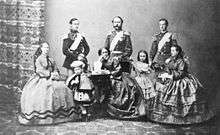
Although he was of royal blood (his mother and father were both great-grandchildren of King Frederick V of Denmark and great-great-grandchildren of King George II of Great Britain) his family was relatively obscure and lived a comparatively normal life by royal standards. In 1853, however, George's father was designated the heir presumptive to the childless King Frederick VII of Denmark, and the family became princes and princesses of Denmark. George's siblings were Frederick (who succeeded their father as King of Denmark, and whose second son was elected as King Haakon VII of Norway in 1905), Alexandra (who became wife of King Edward VII of the United Kingdom and the mother of King George V), Dagmar (who, as Empress Maria Feodorovna, was consort of Emperor Alexander III of Russia and the mother of Emperor Nicholas II), Thyra (who married Ernest Augustus, Crown Prince of Hanover) and Valdemar.[3]
George's mother tongue was Danish, with English as a second language. He was also taught French and German.[5] He embarked on a career in the Royal Danish Navy, and enrolled as a naval cadet along with his elder brother Frederick. While Frederick was described as "quiet and extremely well-behaved", George was "lively and full of pranks".[6]
King of the Hellenes
Following the overthrow of the Bavarian-born King Otto of Greece in October 1862,[7] the Greek people had rejected Otto's brother and designated successor Luitpold, although they still favored a monarchy rather than a republic. Many Greeks, seeking closer ties to the pre-eminent world power, the United Kingdom, rallied around Prince Alfred, Duke of Edinburgh, second son of Queen Victoria and Prince Albert.[8] British prime minister Lord Palmerston believed that the Greeks were "panting for increase in territory",[9] hoping for a gift of the Ionian Islands, which were then a British protectorate. The London Conference of 1832, however, prohibited any of the Great Powers' ruling families from accepting the crown, and in any event, Queen Victoria was adamantly opposed to the idea. The Greeks nevertheless insisted on holding a plebiscite in which Prince Alfred received over 95% of the 240,000 votes.[10] There were 93 votes for a Republic and six for a Greek.[11] King Otto received one vote.[12]
With Prince Alfred's exclusion, the search began for an alternative candidate. The French favored Henri d'Orléans, duc d'Aumale, while the British proposed Queen Victoria's brother-in-law Ernest II, Duke of Saxe-Coburg and Gotha, her nephew Prince Leiningen, and Archduke Maximilian of Austria, among others. Eventually, the Greeks and Great Powers winnowed their choice to Prince William of Denmark, who had received six votes in the plebiscite.[13] Aged only 17, he was elected King of the Hellenes on 30 March [O.S. 18 March] 1863 by the Greek National Assembly under the regnal name of George I. Paradoxically, he ascended a royal throne before his father,[14] who became King of Denmark on 15 November the same year. There were two significant differences between George's elevation and that of his predecessor, Otto. First, he was acclaimed unanimously by the Greek Assembly, rather than imposed on the people by foreign powers. Second, he was proclaimed "King of the Hellenes" instead of "King of Greece", which had been Otto's style.[15]
His ceremonial enthronement in Copenhagen on 6 June was attended by a delegation of Greeks led by First Admiral and Prime Minister Constantine Kanaris. At the ceremony, it was announced that the British government would cede the Ionian Islands to Greece in honor of the new monarch.[16]
Early reign
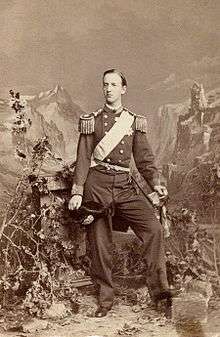
The new 17-year-old king toured Saint Petersburg, London and Paris before departing for Greece from the French port of Toulon on 22 October aboard the Greek flagship Hellas. He arrived in Athens on 30 October [O.S. 18 October] 1863,[17] after docking at Piraeus the previous day.[18] He was determined not to make the mistakes of his predecessor, so he quickly learned Greek.[19] The new king was seen frequently and informally in the streets of Athens, where his predecessor had only appeared in pomp.[20] King George found the palace in a state of disarray, after the hasty departure of King Otto, and took to putting it right by mending and updating the 40-year-old building.[21] He also sought to ensure that he was not seen as too influenced by his Danish advisers, ultimately sending his uncle, Prince Julius, back to Denmark with the words, "I will not allow any interference with the conduct of my government".[22] Another adviser, Count Wilhelm Sponneck, became unpopular for advocating a policy of disarmament and tactlessly questioning the descent of modern Greeks from classical antecedents. Like Julius, he was dispatched back to Denmark.[23]
From May 1864, George undertook a tour of the Peloponnese, through Corinth, Argos, Tripolitsa, Sparta, and Kalamata, where he embarked on the frigate Hellas. Proceeding northwards along the coast accompanied by British, French and Russian naval vessels, the Hellas reached Corfu on 6 June, for the ceremonial handover of the Ionian Islands by the British High Commissioner, Sir Henry Storks.[24]
Politically, the new king took steps to conclude the protracted constitutional deliberations of the Assembly. On 19 October 1864, he sent the Assembly a demand, countersigned by Constantine Kanaris, explaining that he had accepted the crown on the understanding that a new constitution would be finalized, and that if it was not he would feel himself at "perfect liberty to adopt such measures as the disappointment of my hopes may suggest".[25] It was unclear from the wording whether he meant to return to Denmark or impose a constitution, but as either event was undesirable the Assembly soon came to an agreement.
On 28 November 1864, he took the oath to defend the new constitution, which created a unicameral assembly (Vouli) with representatives elected by direct, secret, universal male suffrage, a first in modern Europe. A constitutional monarchy was set up with George deferring to the legitimate authority of the elected officials, although he was aware of the corruption present in elections and the difficulty of ruling a mostly illiterate population.[26] Between 1864 and 1910, there were 21 general elections and 70 different governments.[27]
Internationally, George maintained a strong relationship with his brother-in-law, the Prince of Wales (eventually King Edward VII of the United Kingdom), and sought his help in defusing the recurring and contentious issue of Crete, an overwhelmingly Greek island that remained under Ottoman Turk control. Since the reign of Otto, the Greek desire to unite Greek lands in one nation had been a sore spot with the United Kingdom and France, which had embarrassed Otto by occupying the main Greek port Piraeus to dissuade Greek irredentism during the Crimean War.[28] During the Cretan Revolt (1866–1869), the Prince of Wales sought the support of British Foreign Secretary Lord Derby to intervene in Crete on behalf of Greece.[29] Ultimately, the Great Powers did not intervene and the Ottomans put down the rebellion.[30]
Marriage and children
| House of Glücksburg (Greek branch) |
|---|
.svg.png) |
| George I |
|
George first met Grand Duchess Olga Constantinovna of Russia in 1863, when she was 12 years old, on a visit to the court of Tsar Alexander II between his election to the Greek throne and his arrival in Athens. They met for a second time in April 1867, when George went to the Russian Empire to visit his sister Dagmar, who had married into the Russian imperial family. While George was privately a Lutheran,[31] the Romanovs were Orthodox Christians like the majority of Greeks, and George thought a marriage with a Russian grand duchess would re-assure his subjects on the question of his future children's religion.[32] Olga was just 16 years old when she married George at the Winter Palace in Saint Petersburg on 27 October 1867. After a honeymoon at Tsarskoye Selo, the couple left Russia for Greece on 9 November.[33] Over the next twenty years, they had eight children:
- Constantine (1868–1923), who married Princess Sophia of Prussia;
- George (1869–1957), who married Princess Marie Bonaparte;
- Alexandra (1870–1891), who married Grand Duke Paul Alexandrovich of Russia;
- Nicholas (1872–1938), who married Grand Duchess Elena Vladimirovna of Russia;
- Maria (1876–1940), who married firstly Grand Duke George Mikhailovich of Russia and secondly Admiral Perikles Ioannidis;
- Olga (1880), who died aged seven months;
- Andrew (1882–1944), who married Princess Alice of Battenberg;
- Christopher (1888–1940), who married firstly American widow Nancy Stewart Worthington Leeds and secondly Princess Françoise of Orléans.
As a marriage gift, the Tsar gave George a group of islands in the Petalioi Gulf, which the family visited on the royal yacht Amphitrite. George later purchased a country estate, Tatoi, north of Athens, and on Corfu he built a summer villa called Mon Repos.[34] George developed Tatoi, building roads and planting grapes for making his own wine, Chateau Décélie.[35] Intent on not letting his subjects know that he missed Denmark, he discreetly maintained a dairy at his palace at Tatoi, which was managed by native Danes and served as a bucolic reminder of his homeland.[36] Queen Olga was far less careful in hiding her nostalgia for her native Russia, often visiting Russian ships at Piraeus two or three times before they weighed anchor.[37] When alone with his wife, George usually conversed in German. Their children were taught English by their nannies, and when talking with his children he therefore spoke mainly English.[38]
The King was related by marriage to the British, Russian and Prussian monarchs, maintaining a particularly strong attachment to the Prince and Princess of Wales, who visited Athens in 1869. Their visit occurred despite continued lawlessness which culminated in the kidnap of a party of British and Italian tourists, including Lord and Lady Muncaster. Two female hostages, a child and Lord Muncaster were released, but four of the others were murdered: British diplomat E. H. C. Herbert (the first cousin of Lord Carnarvon), Frederick Vyner (the brother-in-law of Lord Ripon, Lord President of the Council), Italian diplomat Count Boyl di Putifigari, and Mr. Lloyd (an engineer).[39][40] George's relationships with other ruling houses assisted him and his small country but also often put them at the center of national political struggles in Europe.[41]
From 1864 to 1874, Greece had 21 governments, the longest of which lasted a year and a half.[42] In July 1874, Charilaos Trikoupis, a member of the Greek Parliament, wrote an anonymous article in the newspaper Kairoi blaming King George and his advisors for the continuing political crisis caused by the lack of stable governments. In the article, he accused the King of acting like an absolute monarch by imposing minority governments on the people. If the King insisted, he argued, that only a politician commanding a majority in the Vouli could be appointed prime minister, then politicians would be forced to work together more harmoniously in order to construct a coalition government. Such a plan, he wrote, would end the political instability and reduce the large number of smaller parties. Trikoupis admitted to writing the article after a man supposed by the authorities to be the author was arrested, whereupon he was taken into custody himself. After a public outcry, he was released and subsequently acquitted of the charge of "undermining the constitutional order". The following year, the King asked Trikoupis to form a government (without a majority) and then read a speech from the throne declaring that in future the leader of the majority party in parliament would be appointed prime minister.[43]
Territorial expansion
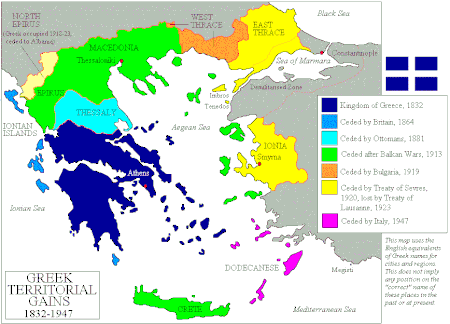
Throughout the 1870s, Greece kept pressure on the Ottoman Empire, seeking territorial expansion into Epirus and Thessaly. The Russo-Turkish War of 1877–1878 provided the first potential alliance for the Greek kingdom. George's sister Dagmar was the daughter-in-law of Alexander II of Russia, and she sought to have Greece join the war. The French and British refused to countenance such an act, and Greece remained neutral. At the Congress of Berlin convened in 1878 to determine peace terms for the Russo-Turkish War, Greece staked a claim to Crete, Epirus and Thessaly.[44]
The borders were still not finalized in June 1880 when a proposal very favorable to Greece that included Mount Olympus and Ioannina was offered by the British and French. When the Ottoman Turks strenuously objected, Prime Minister Trikoupis made the mistake of threatening a mobilization of the Hellenic Army. A coincident change of government in France, the resignation of Charles de Freycinet and his replacement with Jules Ferry, led to disputes among the Great Powers and, despite British support for a more pro-Greek settlement, the Turks subsequently granted Greece all of Thessaly but only the part of Epirus around Arta. When the government of Trikoupis fell, the new prime minister, Alexandros Koumoundouros, reluctantly accepted the new boundaries.[45]
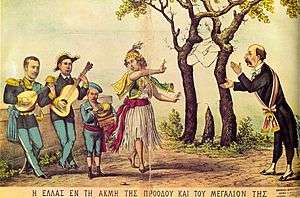
While Trikoupis followed a policy of retrenchment within the established borders of the Greek state, having learned a valuable lesson about the vicissitudes of the Great Powers, his main opponents, the Nationalist Party led by Theodoros Deligiannis, sought to inflame the anti-Turkish feelings of the Greeks at every opportunity. The next opportunity arose in 1885 when Bulgarians rose in revolt in Eastern Rumelia and united the province with Bulgaria. Deligiannis rode to victory over Trikoupis in elections that year saying that if the Bulgarians could defy the Treaty of Berlin, so should the Greeks.[45]
Deligiannis mobilized the Hellenic Army, and the British Royal Navy blockaded Greece. The admiral in charge of the blockade was Prince Alfred, Duke of Edinburgh, who had been the first choice of the Greeks to be their king in 1863,[45] and the First Lord of the Admiralty at the time was Lord Ripon, whose brother-in-law had been murdered in Greece 16 years before.[46] This was not the last time that King George discovered that his family ties were not always to his advantage. Deligiannis was forced to demobilize and Trikoupis regained the premiership. Between 1882 and 1897, Trikoupis and Deligiannis alternated the premiership as their fortunes rose and fell.[47]
National progress

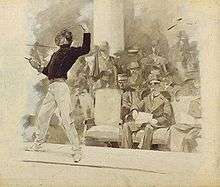
George's silver jubilee in 1888 was celebrated throughout the Hellenic world, and Athens was decorated with garlands for the anniversary of his accession on 30 October.[48] Visitors included the Crown Prince of Denmark, the Prince and Princess of Wales, the Duke and Duchess of Edinburgh, Grand Dukes Sergei and Paul of Russia, and Djevad Pasha from the Ottoman Empire, who presented the King with two Arabian horses as gifts.[49] Jubilee events in the week of 30 October included balls, galas, parades, a thanksgiving service at the Metropolitan Cathedral of Athens, and a lunch for 500 invited guests in a blue and white tent on the Acropolis.[50]
Greece in the last decades of the 19th century was increasingly prosperous and was developing a sense of its role on the European stage. In 1893, the Corinth Canal was built by a French company cutting the sea journey from the Adriatic Sea to Piraeus by 150 miles (241 km). In 1896, the Olympic Games were revived in Athens, and the Opening Ceremony of the 1896 Summer Olympics was presided over by the King. When Spiridon Louis, a shepherd from just outside Athens, ran into the Panathinaiko Stadium to win the Marathon event, the Crown Prince ran down onto the field to run the last thousand yards beside the Greek gold medalist, while the King stood and applauded.[51]
The popular desire to unite all Greeks within a single territory (Megali Idea) was never far below the surface and another revolt against Turkish rule erupted in Crete. In February 1897, King George sent his son, Prince George, to take possession of the island.[52][53] The Greeks refused an Ottoman offer of an autonomous administration, and Deligiannis mobilized for war.[54] The Great Powers refused to allow the expansion of Greece, and on 25 February 1897 announced that Crete would be under an autonomous administration and ordered the Greek and Ottoman Turk militias to withdraw.[55]
The Turks agreed, but Prime Minister Deligiannis refused and dispatched 1400 troops to Crete under the command of Colonel Timoleon Vassos. While the Great Powers announced a blockade, Greek troops crossed the Macedonian border and Abdul Hamid II declared war. The announcement that Greece was finally at war with the Turks was greeted by delirious displays of patriotism and spontaneous parades in honor of the King in Athens. Volunteers by the thousands streamed north to join the forces under the command of Crown Prince Constantine.[56]
The war went badly for the ill-prepared Greeks; the only saving grace was the swiftness with which the Hellenic Army was overrun. By the end of April 1897, the war was lost. The worst consequences of defeat for the Greeks were mitigated by the intervention of the King's relations in Britain and Russia; nevertheless, the Greeks were forced to give up Crete to international administration, and agree to minor territorial concessions in favor of the Turks and an indemnity of 4 million Turkish pounds.[57]
The jubilation with which Greeks had hailed their king at the beginning of the war was reversed in defeat. For a time, he considered abdication. It was not until the King faced down an assassination attempt on 27 February 1898 with great bravery that his subjects again held their monarch in high esteem.[58] Returning from a trip to the beach at Phaleron in an open carriage, George and his daughter Maria were shot at by two riflemen. The King tried to shield his daughter; both were unhurt though the coachman and a horse were wounded. The gunmen (an Athens clerk called Karditzis and his assistant) fled into the Hymettus hills but they were spotted and arrested. Both were beheaded at Nauplia.[59]
Later that year, after continued unrest in Crete, which included the murder of the British vice-consul,[60] Prince George of Greece was made the Governor-General of Crete under the suzerainty of the Sultan, after the proposal was put forward by the Great Powers. Greece was effectively in day-to-day control of Crete for the first time in modern history.[52]
Later reign and assassination
The death of Britain's Queen Victoria on 22 January 1901 left King George as the second-longest-reigning monarch in Europe.[61] His always cordial relations with his brother-in-law, the new King Edward VII, continued to tie Greece to Britain. This was abundantly important in Britain's support of King George's son Prince George as Governor-General of Crete. Nevertheless, Prince George resigned in 1906 after a leader in the Cretan Assembly, Eleftherios Venizelos, campaigned to have him removed.[62]
As a response to the Young Turk Revolution of 1908, Venizelos's power base was further strengthened, and on 8 October 1908 the Cretan Assembly passed a resolution in favor of union despite both the reservations of the Athens government under Georgios Theotokis[63] and the objections of the Great Powers.[64] The muted reaction of the Athens Government to the news from Crete led to an unsettled state of affairs on the mainland.[65]
In August 1909, a group of army officers that had formed a military league, Stratiotikos Syndesmos, demanded, among other things, that the royal family be stripped of their military commissions. To save the King the embarrassment of removing his sons from their commissions, they resigned them.[66] The military league attempted a coup d'état, and the King insisted on supporting the duly elected Hellenic Parliament in response. Eventually, the military league joined forces with Venizelos in calling for a National Assembly to revise the constitution. King George gave way, and new elections to the revising assembly were held in August 1910. After some political maneuvering, Venizelos became prime minister of a minority government. Just a month later, Venizelos called new elections for 11 December [O.S. 28 November] 1910, at which he won an overwhelming majority after most of the opposition parties declined to take part.[67]
Venizelos and the King were united in their belief that the nation required a strong army to repair the damage of the humiliating defeat of 1897. Crown Prince Constantine was reinstated as Inspector-General of the Army,[68] and later Commander-in-Chief. Under his and Venizelos's close supervision the military was retrained and equipped with French and British help, and new ships were ordered for the Hellenic Navy. Meanwhile, through diplomatic means, Venizelos had united the Christian countries of the Balkans in opposition to the ailing Ottoman Empire.[69]
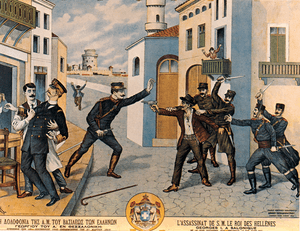
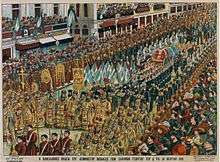
When the Kingdom of Montenegro declared war on Turkey on 8 October 1912, it was joined quickly by Serbia, Bulgaria, and Greece in what is known as the First Balkan War. George was on vacation in Denmark, so he immediately returned to Greece via Vienna, arriving in Athens to be met by a large and enthusiastic crowd on the evening of 9 October.[70] The results of this campaign differed radically from the Greek experience at the hands of the Turks in 1897.[71] The well-trained Greek forces, 200,000 strong, won victory after victory.[72] On 9 November 1912, Greek forces commanded by Crown Prince Constantine rode into Thessaloniki, just a few hours ahead of a Bulgarian division. Three days later King George rode in triumph through the streets of Thessaloniki, the second-largest Greek city, accompanied by the Crown Prince and Venizelos.[73][74]

As he approached the fiftieth anniversary of his accession, the King made plans to abdicate in favor of his son Constantine immediately after the celebration of his golden jubilee in October 1913.[75] Just as he did in Athens, George went about Thessaloniki without any meaningful protection force. While out on an afternoon walk near the White Tower on 18 March 1913, he was shot at close range in the back by Alexandros Schinas, who was "said to belong to a Socialist organization" and "declared when arrested that he had killed the King because he refused to give him money".[76] George died instantly, the bullet having penetrated his heart.[77] The Greek government denied any political motive for the assassination, saying that Schinas was an alcoholic vagrant.[78] Schinas was tortured in prison[79] and six weeks later fell to his death from a police station window.[80]
The King's body was taken to Athens on the Amphitrite, escorted by a flotilla of naval vessels.[81] For three days the coffin of the King, draped in the Danish and Greek flags, lay in the Metropolitan Cathedral in Athens before his body was committed to a tomb at his palace in Tatoi.[82]
Titles, styles, honours and arms
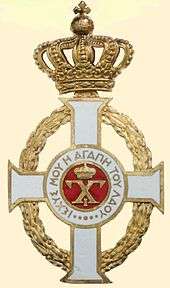
Titles and styles
- 24 December 1845 – 31 July 1853: His Highness Prince William of Schleswig-Holstein-Sonderburg-Glücksburg
- 31 July 1853 – 21 December 1858: His Highness Prince William of Denmark
- 21 December 1858 – 30 March 1863: His Royal Highness Prince William of Denmark
- 30 March 1863 – 18 March 1913: His Majesty The King of the Hellenes
Honours

- Knight of the Elephant, 6 June 1863 – during his enthronement ceremony as King of the Hellenes[85]
- Cross of Honour of the Order of the Dannebrog, 9 September 1863
- Grand Commander of the Dannebrog, 30 June 1871
- Commemorative Medal for the Golden Wedding of King Christian IX and Queen Louise

.svg.png)
_crowned.svg.png)
.svg.png)

.svg.png)
.svg.png)
.svg.png)
.svg.png)
- Grand Cross of the Order of Charles III, 12 May 1869[91]
- Knight of the Golden Fleece, 12 November 1871[92]
- Grand Cross of Naval Merit, with White Decoration, 27 January 1892[93]




.svg.png)
.svg.png)

- Knight of the Garter, 12 July 1876[100]
- Honorary Grand Cross of the Royal Victorian Order, 8 March 1901[101]
- Royal Victorian Chain, 1905[102]
.svg.png)
.svg.png)

.svg.png)
.svg.png)
Military appointments
- Admiral of the Fleet of the Danish Navy[84]
Arms
.svg.png)
The distinctive Greek flag of blue and white cross was first hoisted during the Greek War of Independence in March 1822.[106] This was later modified so that the shade of blue matched that of the Bavarian coat of arms of the first King of Greece, Otto.[107] The shield is emblazoned with a smaller version of coat of arms of the Danish Royal Family, including the three lions of the arms of Denmark proper, the two lions of Schleswig, the nettle leaf of Holstein, the horse head of Lauenburg, the two red bars of the House of Oldenburg and the cross of Delmenhorst. The supporters on either side both depicting Heracles are quite similar to the two wild men from the Danish royal arms. Beneath the shield is the motto in Greek, Ἰσχύς μου ἡ αγάπη τοῦ λαοῦ ("The people's love is my strength"). Beneath the motto dangles the Grand Cross of the Order of the Redeemer, Greece's premier decoration of honor.[108]
Ancestry
| Ancestors of George I of Greece | |||||||||||||||||||||||||||||||||||||||||||||||||||||||||||||||||||||||||||||||||||||||||||||||||||||||||||||||||||||||||||||||||||||||||||||||||||||||||||||||||||||||||||||||||||||||||||||||||||||||||||||||||||||||||||||||||||||||||||||||||||||||||||||||||||||||||||||||||||||||||
|---|---|---|---|---|---|---|---|---|---|---|---|---|---|---|---|---|---|---|---|---|---|---|---|---|---|---|---|---|---|---|---|---|---|---|---|---|---|---|---|---|---|---|---|---|---|---|---|---|---|---|---|---|---|---|---|---|---|---|---|---|---|---|---|---|---|---|---|---|---|---|---|---|---|---|---|---|---|---|---|---|---|---|---|---|---|---|---|---|---|---|---|---|---|---|---|---|---|---|---|---|---|---|---|---|---|---|---|---|---|---|---|---|---|---|---|---|---|---|---|---|---|---|---|---|---|---|---|---|---|---|---|---|---|---|---|---|---|---|---|---|---|---|---|---|---|---|---|---|---|---|---|---|---|---|---|---|---|---|---|---|---|---|---|---|---|---|---|---|---|---|---|---|---|---|---|---|---|---|---|---|---|---|---|---|---|---|---|---|---|---|---|---|---|---|---|---|---|---|---|---|---|---|---|---|---|---|---|---|---|---|---|---|---|---|---|---|---|---|---|---|---|---|---|---|---|---|---|---|---|---|---|---|---|---|---|---|---|---|---|---|---|---|---|---|---|---|---|---|---|---|---|---|---|---|---|---|---|---|---|---|---|---|---|---|---|---|---|---|---|---|---|---|---|---|---|---|---|---|---|---|---|
| |||||||||||||||||||||||||||||||||||||||||||||||||||||||||||||||||||||||||||||||||||||||||||||||||||||||||||||||||||||||||||||||||||||||||||||||||||||||||||||||||||||||||||||||||||||||||||||||||||||||||||||||||||||||||||||||||||||||||||||||||||||||||||||||||||||||||||||||||||||||||
Notes and sources
- Throughout George's lifetime, Greece used the Old Style Julian calendar. Unless otherwise indicated, all dates in this article are in the New Style Gregorian calendar.
- At the time of the King's assassination, Thessaloniki was in occupied Ottoman territory. The city was recognized as part of the Kingdom of Greece by the Treaty of Bucharest (1913) five months afterwards.
- Van der Kiste, p. 6
- Van der Kiste, pp. 6–8
- Van der Kiste, p. 7; see also Christmas, pp. 22, 403
- Christmas, p. 45
- Lidderdale, H. A. (editor and translator) (1966). Makriyannis: The Memoirs of General Makriyannis 1797–1864. Oxford University Press. p. 212.
- "History of the Constitution". Official web-site of the Hellenic Parliament. Archived from the original on 10 February 2007. Retrieved 12 February 2007.
- Van der Kiste, p. 4
- Clogg, p. 82
- Forster, p. 17
- Christmas, p. 37; Van der Kiste, p. 5
- Christmas, pp. 39–41
- Van der Kiste, pp. 6–11
- Woodhouse, p. 170
- The Times (London), 8 June 1863, p. 12, col. C
- Forster, p. 18
- Van der Kiste, pp. 14–15
- Van der Kiste, p. 18
- Van der Kiste, p. 16
- Van der Kiste, pp. 16–17
- The Times (London), 14 February 1865, p. 10, col. C
- Christmas, pp. 73–74
- Christmas, pp. 65–66
- Royal Message to the National Assembly, 6 October 1864, quoted in The Times (London), 31 October 1864, p. 9, col. E
- Campbell and Sherrard, p. 99
- Woodhouse, p. 172
- Woodhouse, p. 167
- Van der Kiste, p. 23
- Clogg, p. 87
- Van der Kiste, pp. 10, 18
- Van der Kiste, p. 24
- Christmas, p. 83
- Christmas, pp. 140–141
- Christmas, p. 149
- Van der Kiste, p. 37
- Van der Kiste, p. 39
- Forster, p. 74
- Christmas, pp. 86–91
- The King of the Hellenes to the Prince of Wales, April 1870. In: Letters of Queen Victoria 1870–1878 (1926) London: John Murray, vol. II, p. 16
- Christmas, pp. 93–95
- Ministry of Epameinondas Deligeorgis, 20 July 1872 – 21 February 1874
- Clogg, p. 86
- Clogg, p. 89
- Woodhouse, p. 181
- Van der Kiste, p. 35
- Clogg, pp. 90–92
- Christmas, p. 119
- Christmas, p. 120
- Christmas, pp. 121–123
- Van der Kiste, pp. 54–55
- Woodhouse, p. 182
- The Times (London), 12 February 1897, p. 9, col. E
- Clogg, p. 93
- The Times (London), 25 February 1897, p. 5, col. A
- Mehmet Uğur Ekinci (2006). "The Origins of the 1897 Ottoman-Greek War: A Diplomatic History" (PDF). M.A. Thesis. Bilkent University, Ankara. Retrieved 12 February 2007.
- Clogg, p. 94
- The Times (London), 28 February 1898, p. 7, col. A
- Christmas, pp. 269–270
- Forster, p. 33
- Van der Kiste, p. 63
- Woodhouse, p. 186
- Campbell and Sherrard, pp. 109–110
- Forster, p. 44
- Christmas, pp. 281–282
- Van der Kiste, pp. 68–69
- Clogg, pp. 97–99
- Clogg, p. 100
- Clogg, pp. 101–102
- Christmas, pp. 348–349
- Christmas, p. 328
- Christmas, pp. 349–359
- The Times (London), 26 November 1912, p. 11, col. C
- Christmas, pp. 362–365
- Christmas, p. 403
- The Times (London), 19 March 1913, p. 6
- Christmas, p. 408
- The Times (London), 20 March 1913, p. 6
- The New York Times, 20 March 1913, p. 3
- The New York Times, 7 May 1913, p. 3
- Christmas, p. 413
- Van der Kiste, p. 77
- "The Royal Order of King George I" (PDF). Official website of the Greek royal family. Retrieved 7 October 2012.
- Bille-Hansen, A. C.; Holck, Harald, eds. (1912) [1st pub.:1801]. Statshaandbog for Kongeriget Danmark for Aaret 1912 [State Manual of the Kingdom of Denmark for the Year 1912] (PDF). Kongelig Dansk Hof- og Statskalender (in Danish). Copenhagen: J.H. Schultz A.-S. Universitetsbogtrykkeri. pp. 3, 6. Retrieved 16 September 2019 – via da:DIS Danmark.
- Christmas, p. 54
- Sergey Semenovich Levin (2003). "Lists of Knights and Ladies". Order of the Holy Apostle Andrew the First-called (1699-1917). Order of the Holy Great Martyr Catherine (1714-1917). Moscow.
- "A Szent István Rend tagjai" Archived 22 December 2010 at the Wayback Machine
- Justus Perthes, Almanach de Gotha (1913) p. 40
- Sveriges statskalender (in Swedish). 1905. p. 465. Retrieved 6 January 2018 – via runeberg.org.
- Staatshandbücher für das Herzogtum Sachsen-Coburg und Gotha (1884), "Herzogliche Sachsen-Ernestinischer Hausorden" p. 31
- "Real y distinguida orden de Carlos III", Guía Oficial de España (in Spanish), 1887, p. 155, retrieved 21 March 2019
- "Caballeros de la insigne orden del toisón de oro", Guía Oficial de España (in Spanish), 1887, p. 146, retrieved 21 March 2019
- Bollettino Ufficiale di Stato
- Hof- und Staats-Handbuch für des Herzogtum Anhalt (1883), "Herzoglicher Haus-Orden Albrecht des Bären" p. 16
- Hof- und Staatshandbuch des Herzogtums Braunschweig für das Jahr 1897, "Herzogliche Orden Heinrich des Löwen" p. 10
- Daniel Corston. "Unofficial website dedicated to the Grand Ducal House of Mecklenburg-Strelitz". mecklenburg-strelitz.org.
- Hof- und Staats-Handbuch des Königreich Württemberg (1907), "Königliche Orden" p. 27
- Staatshandbuch für das Großherzogtum Sachsen / Sachsen-Weimar-Eisenach (1900), "Großherzogliche Hausorden" p. 15
- Hof- und Staats-Handbuch des Großherzogtum Baden (1902), "Großherzogliche Orden" p. 66
- Shaw, Wm. A. (1906) The Knights of England, I, London, p. 65
- Shaw, p. 424
- "No. 27859". The London Gazette. 1 December 1905. p. 8643.
- M. & B. Wattel (2009). Les Grand'Croix de la Légion d'honneur de 1805 à nos jours. Titulaires français et étrangers. Paris: Archives & Culture. p. 429. ISBN 978-2-35077-135-9.
- Hof- und Staats-Handbuch des Königreichs Bayern (1906), "Königliche-Orden" p. 8
- "Ordinul Carol I" [Order of Carol I]. Familia Regală a României (in Romanian). Bucharest. Retrieved 17 October 2019.
- Smith, Whitney (1980). Flags and Arms Across the World. London: Cassell. p. 99.
- Maclagan, Michael; Louda, Jiří (1999). Lines of Succession: Heraldry of the Royal Families of Europe. London: Little, Brown & Co. p. 281. ISBN 1-85605-469-1.
- Maclagan and Louda, p. 285
References
- Campbell, John; Sherrard, Philip (1968). Modern Greece. London: Ernest Benn.
- Christmas, Walter (1914). King George of Greece. Translated by A. G. Chater. New York: McBride, Nast & Company.
- Clogg, Richard (1979). A Short History of Modern Greece. Cambridge University Press.
- Forster, Edward S. (1958). A Short History of Modern Greece 1821–1956 3rd edition. London: Methuen and Co.
- Van der Kiste, John (1994). Kings of the Hellenes. Stroud, Gloucestershire: Sutton Publishing. ISBN 0-7509-0525-5.
- Woodhouse, C. M. (1968). The Story of Modern Greece. London: Faber and Faber.
External links
| Wikimedia Commons has media related to George I of Greece. |
- Vilhelm (Georg I) at the website of the Royal Danish Collection at Amalienborg Palace
George I of Greece House of Schleswig-Holstein-Sonderburg-Glücksburg Cadet branch of the House of Oldenburg Born: 24 December 1845 Died: 18 March 1913 | ||
| Regnal titles | ||
|---|---|---|
| Preceded by Otto as King of Greece |
King of the Hellenes 30 March 1863 – 18 March 1913 |
Succeeded by Constantine I |
.svg.png)
